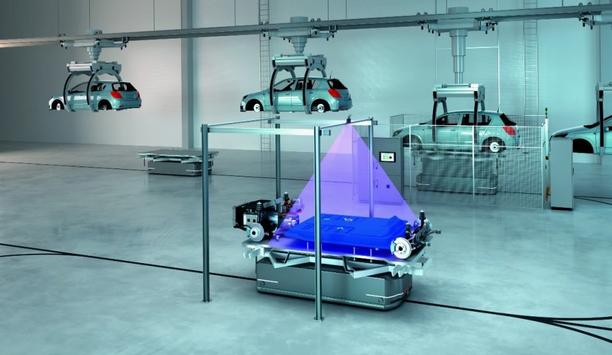SICK AG - Experts & Thought Leaders
Latest SICK AG news & announcements
Themed “Airport Operations for Tomorrow”, inter airport Southeast Asia 2025 (IASEA) curated a lineup of conference sessions and the latest innovations to drive conversations on what a sustainable tomorrow looks like for Asia’s airport operations and ground handling industry. From 25-27 March 2025, the 8th edition of IASEA is expected to gather over 4,000 attendees, 150 notable global brands and some 50 industry experts as speakers at the iconic Marina Bay Sands, Singapore. IASEA 2025 Conference–Mastermind keynotes The session will discuss keys that improve operational efficiencies and lay the foundation for resilient Setting the stage for this conference on day 1 (25 March) is the fireside chat titled Reshaping Global Airport Operations by Patrick Ky, CEO, International Centre for Aviation Innovation (ICAI), an industry pioneer with nearly three decades worth of aviation experience. Moderated by Glory Wee, Senior Director, Aviation Development Group, Civil Aviation Authority Singapore (CAAS), the session will discuss solutions that improve operational efficiencies and lay the foundation for resilient and future-proof airports. Next-generation air navigation services “Globally, Asia Pacific takes the lead as the region with 60% of the total number of airport projects, and the region’s carriers handled 31 million international passengers, which was a 19.8% increase in November 2024 compared to November 2023. Recognising the need to address ground and airspace capacity constraints and manpower shortages, while keeping up with increasing passenger footfall in the region, the International Centre for Aviation Innovation was established in Singapore,” said Patrick Ky, CEO, International Centre for Aviation Innovation (ICAI). “ICAI focuses on research and development projects for next-generation air navigation services, automated and smart airports, and unmanned aviation systems and sustainable aviation. At the upcoming IASEA 2025, I’m excited to share insights into new innovations that will be tested in Singapore before being deployed globally.” Skytrax’s World Top Airport List 2024 Keynote sessions led by two of the top 5 airports according to Skytrax’s World Top Airport List 2024 This will be followed by keynote sessions led by two of the top 5 airports according to Skytrax’s World Top Airport List 2024. The first keynote, Airports of The Next Decade & Beyond with Shinichiro Motomiya, General Manager, Narita International Airport Corporation, will provide insights into the master plan of Narita International Airport – a case study of the airport of the future, and Airport in Brief: Incheon Airport with Soonil Hwang, Deputy Director of Fast Travel Team, Incheon International Airport Corporation, will cover a deep dive into the airport’s Digital Transformation Project. New Narita Airport expansion project Shinichiro Motomiya, General Manager, Narita International Airport Corporation, shared, “To ensure that airports can keep up with this surging demand in air traffic today, it’s become paramount for the industry to accelerate conversations on what will make airports sustainable, improve operational resilience and passenger experience. Take the ‘New Narita Airport’ expansion project as a case in point, which we will share about during the keynote session." "The airport development project for the 2030s is looking at consolidating terminals and building a new cargo area to allow for the expected increase of passenger capacity from 57 to 75 million and cargo capacity from 2.4 to 3.5 million tons at Narita International Airport.” Use of Artificial Intelligence technologies Soonil Hwang, Deputy Director of the Fast Travel Team, Incheon International Airport Corporation commented, “We should not shun away from the use of Artificial Intelligence technologies, especially in the aviation industry. At Incheon International Airport, we believe that technology will strike a fine balance between passenger experience and operational efficiency." "Hence, we’ve analysed customer demands and drawn a Persona Journey Map to design solutions around it. As we complete Phase 4 of the transformation of Incheon International Airport, it is my pleasure to share at the upcoming IASEA how we’ve identified values such as ‘Convenient Journey’ or ‘Time’ and utilised them to elevate the customer experience.” Challenges in ground management Minh will cover the solutions needed to address challenges in ground management The morning of the opening day will also see Nguyen Dang Minh, Head of Airport Operations Department, Airports Corporation of Vietnam (ACV) spearhead the next keynote, Vietnam Airport Development Masterplan 2030. Vietnam stands as a pioneer in the aviation landscape, aiming to expand its airport network to 30 airports by 2030 and a long-term vision extending to 2050 that includes upgrades to increase annual passenger capacity by over 80%. As new airports are being built and existing ones upgraded, Minh will cover the solutions needed to address challenges in ground management, security, and resource allocation that will enable airport operations to evolve alongside Vietnam’s expanding aviation network. How transformative technology, greener practices Day 2 of the conference will open with the keynote Global Action Plan for the Prevention of Runway Incursion. With safety as a top priority for the aviation industry, and runway incursions as one of the top five high-risk categories of aviation risks, the session will be led by Mitch Fox, Director, Asia Pacific Centre for Aviation Safety, Flight Safety Foundation, who will cover recommendations from the Global Action Plan for the Prevention of Runway Incursions (GAPRI) that go beyond simple regulatory compliance. Aside from safety, efficiency and sustainability are the next priorities to drive airports of tomorrow. Brad Moore, CEO, APAC, Swissport International AG, will lead the next keynote Redefining Ground Support Excellence in Asia Pacific to examine how transformative technology, greener practices, and strategic innovation are unlocking new opportunities for ground handling – a critical backbone of the aviation system. Aside from these mastermind keynotes, other industry experts and thought pioneers from the airport industry will join the conference, sharing their groundbreaking strategies for transforming terminal and ramp operations to address the challenges of today's demanding and rapidly changing aviation landscape. Some of the conference highlights Using Data Analytics to Optimise Airport Operations Rethinking Passenger Flow: Unravelling the Knot of Terminal Congestion Transforming Baggage Handling: Best Practices for Modern Airports Future-Proofing Airport Security: Balancing Safety, Technology & Passenger Experience Boosting Operational Resilience: Preparing for the Unexpected State-of-the-art solutions at inter airport Southeast Asia 2025 As the reference point for the future of airports, IASEA 2025 will stand as a platform to unveil the latest aviation technologies aimed at streamlining workflows, improving sustainability and elevating operational capabilities. Automation will continue to play a pivotal role in ever-growing passenger expectations. SITA’s 2024 Baggage IT Insights reveal that 80% of airports and 66% of airlines have put touchless self-service baggage handling in place, and more investments will continue in 2025. Award-winning airport management software Aligned with this change, industry expert Smith Detection will introduce to the Asia market the SDX 10060 XDi Aligned with this transformation, industry expert Smith Detection will introduce to the Asia market the SDX 10060 XDi, a ground-breaking X-ray scanner, offering highly accurate material discrimination and substance identification based on an object’s molecular structure. Separately, biometrics and digital identity pioneer NEC will showcase its facial recognition technology, ranked the world’s most accurate in a benchmark test conducted by the U.S. National Institute of Standards and Technology in 2024. ADB Safegate Singapore, who recently clinched awards for Environmental Initiatives, Innovation, Safety, and Business Expansion at the Airport Technology Excellence Awards 2024, will present their award-winning airport management software. Other notable brands to expect on the exhibition floor Aviaco GSE, CIAS, Colibri Energy, Cobus Industries, Datalogic, ewo, FAAC, Fastcharge, FibreFENCE by Fibre Net Spa, FLEX Industries, GRP Iluminacion, Honeywell, ITW GSE, Japan Radio Co., LEONARDO, Mallaghan, Mototok, NEC, OCEM Airfield, Oshkosh AeroTech, Poltrona Frau, Roypow Technology GmbH, SICK AG, ShinMaywa, Thales, TCR, TLD Asia, Toyota Industries Corporation, TREPEL and Weihai Guangtai. All registered professionals for inter airport Southeast Asia 2025 will be granted free access to the exhibition and conference floors. For the latest information on inter airport Southeast Asia, please visit the event website, LinkedIn, or Facebook pages.
In the race to hit ambitious global net zero targets, a further two billion EVs need to be on the road by 2050, according to the International Energy Agency. To power these green motors, lithium-ion batteries are essential. But what happens when those batteries are defective? Even before assembly into a working engine, traction batteries are typically transported with a small level of charge. This is because a fully discharged battery poses problems for both the manufacturer and consumer; problems such as lower capacity, faster depletion, and electric shorts which can cause fires to ignite. Detecting at-risk batteries Unexpected ignition can cause catastrophic damage to life, vehicles, and transport infrastructure Regardless of where in the supply chain this occurs, unexpected ignition can cause catastrophic damage to life, vehicles, and transport infrastructure. SICK AG, a market pioneer in the global sensor manufacturing industry, has developed a system for detecting at-risk batteries, helping businesses prevent battery fires before they can cause serious damage. Fighting battery fires Having successfully developed a system that detects hot spots and potential fires on ferries and in tunnels vital to transport infrastructure, such as Switzerland’s 10.5-mile-long Gotthard Road Tunnel, SICK AG was recently presented with an exciting opportunity within an especially challenging timescale. The company was approached by a German automotive manufacturer to detect potential issues in EV batteries on a new assembly line. Thermal imaging technology SICK AG approached Teledyne FLIR to supply the most suitable thermal imaging technology for the task The challenge? To design, test, and implement an interface for identifying thermal runaway in battery production in just three months, a process that, by their admittance, would typically take over a year to see through to completion. That's why SICK AG approached Teledyne FLIR to supply the most suitable thermal imaging technology for the task. Area Hotspot Detection System (AHD) The system required a bespoke interface that could accurately test each battery for thermal runaway, and then export and transmit the data to a server to be cross-referenced and analyzed where anomalies were found to be present. After careful consideration of the scale of the hot spots to be detected by this state-of-the-art system, SICK AG chose to build its new Area Hotspot Detection System (AHD) around the FLIR A70. On the line: a complete view of EV battery defects Just one faulty unit could cause irreparable damage to very expensive automobiles, writing them off" How much could one faulty battery cost manufacturers? Lukas Wallimann, Product and Project Manager at SICK AG explains why the system is crucial to automotive manufacturing applications. “The danger here is not simply an isolated battery but the whole facility. Just one faulty unit could cause irreparable damage to very expensive automobiles, writing them off before they’ve even left the assembly line." Checking every unit accurately "Worst still is the millions of pounds worth of valuable machinery sitting idle in a factory if a fire pauses production. Not only could it damage the production line and the wider factory, but also cost thousands for every hour the factory is offline.” To reassure the manufacturers and make the production and implementation of EV batteries as safe as possible, AHD goes beyond other inspection methods to accurately check every unit on the production line. FLIR A70 The FLIR A70 ensures that the AHD has a clear view of every element of each battery through infrared imaging The FLIR A70 ensures that the AHD has a clear view of every element of each battery through infrared imaging, unlike conventional inspections such as laser thermography which can only isolate and measure the temperature of battery components one at a time. This allows AHD to view any areas with elevated heat readings as batteries pass beneath the FLIR A70 thermal imaging camera in real-time. The system alerts staff of potential problems and ensures that units measuring above the accepted temperature threshold are swiftly taken off the line and neutralized before they can cause damage, either physical or reputational. Ease of integration Despite the short turnaround time, SICK AG has created a versatile sensor system that can be integrated with a variety of systems to bring the functionality of the FLIR A70 to virtually any environment. Its customer needed the system to communicate over ProfiNet (the technical standard for data communication over Industrial Ethernet), and remotely store and share data for analysis. Superior inspection whatever the interface The AHD system keeps human operators involved, giving them access to information in real-time that lets them make data-driven decisions based on the situation, unlike a fully automated process that could cause the otherwise viable stock to be discarded. The system can also be integrated into a higher-level system through the TCP/IP interface or into an older system, as the ProfiNet and I/O interfaces make it ideal for retrofitting older production lines to bring them up to speed. Why choose FLIR thermography? “The FLIR A70 camera is very well made, so it’s ideal for use in an industrial environment like automotive manufacturing,” adds Lukas Wallimann. “The housing is robust and the sensor is easy to use and intuitive. I can take it in my hand and feel that it’s a quality product." “Hardware aside, the biggest plus for us was the support from FLIR, through the development period and application engineering. They were always on hand to help with any technical issues or integration queries and they made an otherwise onerous job that much easier.”
One system, one card
DownloadAligning physical and cyber defence for total protection
DownloadUnderstanding AI-powered video analytics
DownloadEnhancing physical access control using a self-service model
DownloadHow to implement a physical security strategy with privacy in mind
Download









